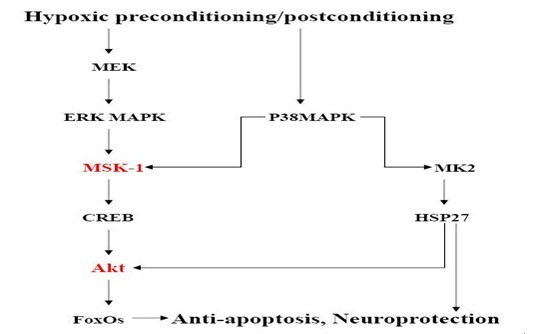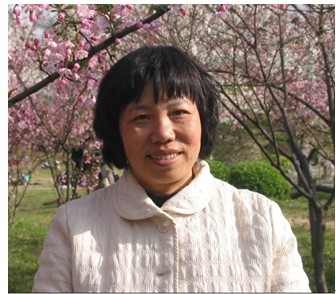研究介绍:
1、低氧预处理/后处理对成年大鼠短暂全脑缺血的神经保护机制研究:包括在体脑缺血模型及体外缺血缺氧模型制作,运用分子生物学、组织化学技术和电子显微镜、激光共聚焦显微镜等相关技术,阐明低氧预处理处理/低氧后处理通过调节信号传导通路,发挥神经保护作用的假说,本研究将为缺血性卒中的防治提供新策略,为临床药物研发开拓新思路。
在成年Wistar大鼠短暂全脑缺血模型中,首次应用低氧预处理/低氧后处理,从不同的信号传导通路及细胞凋亡、自噬等方面对低氧预处理/低氧后处理在成年大鼠短暂全脑缺血再灌注的脑保护作用机制进行深入研究, 完成了低氧预处理/低氧后处理通过Akt/FoxO、 ERK等信号转导通路及维持缺血后脑Na+K+-ATPase活性对短暂性全脑缺血鼠的神经保护作用的研究,文章已在Neuropharmacology》、《Journal of Neurochem》和《Neurochem Int》发表。

Proposed model for the signal transduction pathway triggered by Hypoxic preconditioning/postconditionig showing multiple neuroprotective axes involving in P38MAPK-MSK-1-CREB-Akt-FoxO, P38MAPK-MK2-Hsp27-Akt-FoxO, and MEK-ERK-MSK-1- CREB-Akt-FoxO.
2、研究遗传因素在缺血性脑血管病发病中的作用:完成了脂蛋白脂酶(LPL)HindIII、PvuII、Ser447Ter、载脂蛋白E(ApoE)基因及Hcy代谢相关酶基因如亚甲基四氢叶酸还原酶(MTHFR)、蛋氨酸合成酶还原酶(MTRR)、蛋氨酸合成酶(MS)、转化生长因子-β(TGF-β)基因多态性在脑梗死患者中的分布频率及对血脂、颈动脉斑块和脑梗死影响的研究,从分子遗传学的角度揭示脂质代谢异常在中国人动脉硬化脑梗死发生中的作用。本研究的系列论文先后在《Neuroscience》、《Lipids in Healthy and Disease》等杂志发表。
3、城市社区脑血管病的综合干预与诊治技术研究:通过在广州选取不同的社区,以卒中防治为切入点,通过对社区医师进行脑血管病防治知识培训,研究在社区对卒中高危人群的筛选和干预技术,制定社区医师防治脑卒中的规范路径,探讨开展双向转诊的途径,制定卒中患者的个体化康复、家庭护理以及二级预防方案,形成易于推广的城市社区脑血管病综合防治体系。
参加并完成了国际合作研究项目早期强化降压治疗急性脑出血的效果和安全性的临床试验(INTERACT)以及QUEST研究。作为作者之一,分别在《Lancet Neurol 》、《Stroke》、《Neurology》、《Journal of Hypertension》、《PloS one》上发表研究成果多篇。
References: * : Corresponding author
-
Zhan L, Li D, Liang D, Wu B, Zhu P, Wang Y, Sun W, Xu E*. Activation of Akt/FoxO and Inactivation of MEK/ERK Pathways Contribute to Induction of Neuroprotection against Transient Global Cerebral Ischemia by Delayed Hypoxic Postconditioning in Adult Rats. Neuropharmacology 2012; 63: 873-882.
-
Zhan L, Peng W, Sun W, Xu E*. Hypoxic Preconditioning Induces Neuroprotection against Transient Global Ischemia in Adult Rats via Preserving the Activity of Na+/K+-ATPase. Neurochem Int. 2011;59:65–72
-
Wang Y, Zhan L, Zeng W, Li K, Sun W, Xu ZC, Xu E*. Downregulation of Hippocampal GABA After Hypoxia-Induced Seizures In Neonatal Rats. Neurochem Res 2011; 36:2409-2416
-
Peng Z, Zhan L, Chen S, Xu E*. Association of transforming growth factor-β1 gene C-509T and T869C polymorphisms with atherosclerotic cerebral infarction in the Chinese. Lipids Health Dis 2011,10:100 (IF 2.239)
-
Zhan L, Wang T, Li W, Xu ZC, Sun W, Xu E*. Activation of Akt/FOXO Signaling Pathway Contributes to Induction of Neuroprotection against Transient Global Cerebral Ischemia by Hypoxic Preconditioning in Adult Rats. J Neurochem. 2010; 114: 897–908.
-
Xu E*. Li W, Zhan Z, Guan G, Wang X, Chen S, Shi Y. Polymorphisms of LPL Gene are Associated with Atherosclerotic Cerebral Infarction in the Chinese. Neuroscience. 2008; 155: 403-408
-
Wang X,Sun W, Xu E*. Lipoprotein lipase protein expression and activity is increased after acute cerebral ischemia/reperfusion in rats. Neuropathology. 2010; 30:131-139
-
Xu E*, Wang X, Hao Z, ChenZ, Lu X. Germinoma in the basal ganglia with an abnormal constitutional karyotype: Case study and review of the literature. Childs Nerv Syst. 2010; 26:707-712
-
GUO JJ, Xu E*, Qing-Yuan LIN, Guo-Ling ZENG, Hai-Feng XIE. Effect of Cilostazol on Cerebral Arteries in Secondary Prevention of Ischemic Stroke. Neurosci Bull. 2009; 25(6):383-390.
-
Li K, Xu E*. The role and the mechanism of amma-aminobutyric acid during central nervous system development . Neurosci Bull. 2008; 24: 195-200.
-
Huang Y, Cheng Y, Wu J, Li Y, Xu E, Hong Z, Li Z, Zhang W, Ding M, Gao X, Fan D, Zeng J, Wong K, Lu C, Xiao J, Yao C; on behalf of the cilostazol versus aspirin for secondary ischaemic stroke prevention (CASISP) cooperation investigators.Cilostazol as an alternative to aspirin after ischaemic stroke: a randomised, double-blind, pilot study. Lancet Neurol. 2008 Jun;7(6):494-499.
-
Anderson CS, Huang Y, Wang JG, Arima H, Neal B, Peng B, Heeley E, Skulina C, Parsons MW, Kim JS, Tao QL, Li YC, Jiang JD, Tai LW, Zhang JL, Xu E, Cheng Y, Heritier S, Morgenstern LB, Chalmers J; for the INTERACT Investigators. Intensive blood pressure reduction in acute cerebral haemorrhage trial (INTERACT): a randomised pilot trial. Lancet Neurol. 2008 May;7(5):391-399.
-
Heeley E, Anderson CS, Huang Y, Jan S, Li Y, Liu M, Sun J, Xu E, Wu Y, Yang Q, Zhang J, Zhang S, Wang J; ChinaQUEST Investigators. Role of health insurance in averting economic hardship in families following acute stroke in China. Stroke.2009; 40(6):2149-2156 .
-
Arima H, Wang JG, Huang Y, Heeley E, Skulina C, Parsons MW, Peng B, Li Q, Su S, Tao QL, Li YC, Jiang JD, Tai LW, Zhang JL, Xu E, Cheng Y, Morgenstern LB, Chalmers J, Anderson CS; INTERACT Investigators. Significance of perihaematoma oedema in acute intracerebral haemorrhage: the INTERACT trial. Neurology. 2009, 73:1963-1968. .
-
Anderson CS, Huang Y, Arima H, Heeley E, Skulina C, Parsons MW, Peng B, Li Q, Su S, Tao QL, Li YC, Jiang JD, Tai LW, Zhang JL, Xu E, Cheng Y, Morgenstern LB, Chalmers J, Wang JG; INTERACT Investigators. Effects of early intensive blood pressure lowering treatment on the growth of hematoma and perihematoma edema in acute intracerebral hemorrhage: the INTERACT trial. Stroke. 2010;41:307-312; .
-
Huang Y, Wang J, Wei JW, Headley AP, Wong LKS, Heeley EL, Arima H, Sun J, Li Q, Liu M, Li Z, Wu L, Cheng Y, Huang Q, Zhang S, Xu E, Yang Q, Lu C, Anderson CS, for the ChinaQUEST Investigators. Age and sex variations in the management of ischaemic stroke in China. Int J Stroke. 2010;5:351-359.
-
Wei JW, Wang J, Huang Y, Liu M, Wu Y, Wong LKS, Cheng Y, Xu E, Yang Q, Arima H, Heeley EL, Anderson CS, for the ChinaQUEST Investigators. Secondary prevention of ischemic stroke in urban China. Stroke. 2010; 41:967-974. .
-
Arima H, Anderson CS, Wang JG, Huang Y, Heeley E, Neal B, Woodward M, Skulina C, Parsons MW, Peng B, Tao QL, Li YC, Jiang JD, Tai LW, Zhang JL, Xu E, Cheng Y, Morgenstern LB, Chalmers J; for the INTERACT Investigators*. Lower treatment blood pressure is associated with greatest reduction in hematoma growth after acute intracerebral hemorrhage. Hypertension 2010; 56:852-8.
-
Wei JW, Heeley EL , Jan S, Huang Y, Wang J, Huang Q, ChengY, Xu E, Yang Q , Anderson CS, for the ChinaQUEST Investigators. Variations and determinants of hospital costs for acute stroke in China. PloS one 2010, 5:1-9.
-
Delcourt C, Hackett M, Wu Y, Huang Y, Wang J, Heeley E, Wong L, Sun J, Li Q, Wei JW, Liu M, Li Z, Wu L, Cheng Y, Huang Q, Xu E, Yang Q, Lu C, Anderson CS; for the ChinaQUEST Investigators. Determinants of quality of life after stroke in China: the ChinaQUEST (QUality Evaluation of Stroke care and Treatment) study. Stroke. 2011; 42:433-8. .
-
Haiqiang Jin, Sainan Zhu, Jade W Wei, Jiguang Wang, Ming Liu, Yangfeng Wu, Lawrence K.S. Wong, Yan Cheng, En Xu, Qidong Yang, Craig S. Anderson, Yining Huang, for the ChinaQUEST Investigatiors. Factors associated with pre-hospital delays in the presentation of acute stroke in urban China. Stroke. 2012; 43:362-370..
|






